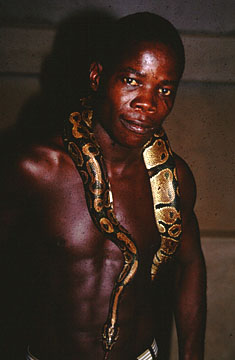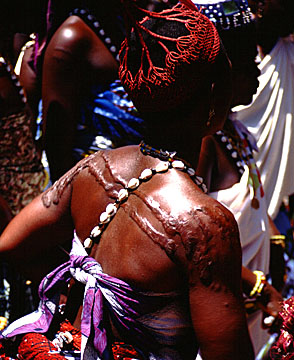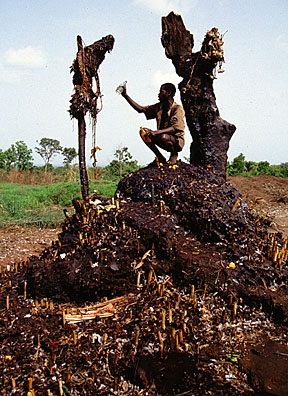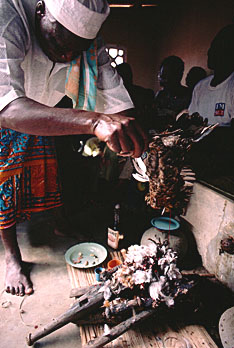|
This is a "Guardian of the Night"spirit dancer. is Dominant in Benin Republic,The
straw-rattan costumes are considered to be houses for the Guardian of the Night. Priests usually demonstrate an empty costume
by showing it to onlookers who can see the inside. It is placed on the ground and prayers are chanted. Suddenly the costume
begins to shake, indicating that the spirit has entered it and taken on its form. At the end of a dance or procession, the
priests will again turn the costume up-side-down and show that it is empty - meaning the spirit has departed. Some times there
will be something left behind such as a bottle with a bird trapped inside. The bottle may be broken and the bird set free
by the priests. There are many variations on this theme. Sometimes dogs or cats appear inside the empty costume and
run away.

Ouidah is well know for its cult of snake worshipers. The Sacred Temple of Serpents
houses over 400 pythons which are tended by a priest cult devoted to the task. Live pythons are worn as ornamentation during
certain voodoorites. The snakes are sacred and are protected under voodoo law. Nobody may kill a python without incurring
the wrath of gods who are the spiritual embodiment of serpents.

Ritual scarification is carried out be some priestesses inthe Voodoo cults of Benin.
These extremely painful episodes are carried out upon advanced priestesses in the hierarchy of the priesthood. The priesthood
is, of course, held in high esteem by the community. Marks such as these are an instant form of visual recognition for the
higher rank of priestesses. Oddly enough, the practice is not done by men or priests.

This is the shrine of Dankoly in central Benin. The shrine is located in the middle
of nowhere and provides a local industry for the priest cult which attends it. Dankoly is the only Voodoo shrine in Benin
used expressly for Revenge purposes. Pilgrims journey to Dankoly to curse their enemies and the gods is much feared. The priest
pours alcoholic spirits and palm oil onto the shrine invoking the gods as the pilgrim pounds a small stake in the ground.
During this action the pilgrim utters his curse and begs the gods to inflict harm on the recipient of the curse. As you can
see, this is a very old shrine. The mound is nearly 7 feet high and is composed of numerous sacrifices of blood, feathers,
oil and alcohol. The many stakes - each bearing a curse - are seen surrounding the shrine mound

The priest in this photo is holding a chicken whose poor unfortunate throat
has been cut. The blood is dripping onto the shrine of the Voodoo god Shango. Shango rules Thunder and Lightning and is much
feared in West Africa. These ceremonies are conducted to appease the god and ensure that calamity does not happen to the community.
This cult is located in Ouidah - Benin - West Africa. Ouidah is the cradle of all Voodoo.
|

